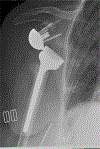Use of a Reverse Shoulder Arthroplasty Following a Fracture-Dislocation with a Brachial Plexus Palsy: A Case Report
- PMID: 29901477
- PMCID: PMC6427917
- DOI: 10.2106/JBJS.CC.17.00204
Use of a Reverse Shoulder Arthroplasty Following a Fracture-Dislocation with a Brachial Plexus Palsy: A Case Report
Abstract
Case: An 80-year-old woman sustained a fracture-dislocation of the proximal aspect of the humerus with a near-complete brachial plexopathy, which was successfully managed acutely using a reverse shoulder arthroplasty (RSA) with repair of the greater and lesser tuberosities. The palsy, which was confirmed with nerve conduction studies, recovered uneventfully along with functional improvement of the shoulder. At the most recent follow-up, there was complete resolution of the plexopathy, with excellent, pain-free range of motion.
Conclusion: Acute RSA with tuberosity repair may be a reasonable treatment modality in the setting of an acute brachial plexus palsy following a comminuted fracture-dislocation of the proximal aspect of the humerus in an elderly patient.
Conflict of interest statement
Figures



Similar articles
-
Reverse shoulder arthroplasty for four-part proximal humerus fracture in elderly patients: can a healed tuberosity improve the functional outcomes?J Shoulder Elbow Surg. 2017 Jul;26(7):1216-1221. doi: 10.1016/j.jse.2016.11.034. Epub 2017 Feb 2. J Shoulder Elbow Surg. 2017. PMID: 28162882
-
Shoulder arthroplasty for the treatment of the sequelae of fractures of the proximal humerus.J Shoulder Elbow Surg. 2001 Jul-Aug;10(4):299-308. doi: 10.1067/mse.2001.115985. J Shoulder Elbow Surg. 2001. PMID: 11517358
-
Reverse shoulder arthroplasty in obstetric brachial plexus injury: our experience with shoulder motion analysis.J Orthop Traumatol. 2023 Nov 10;24(1):59. doi: 10.1186/s10195-023-00736-0. J Orthop Traumatol. 2023. PMID: 37947898 Free PMC article.
-
A systematic review of tuberosity healing and outcomes following reverse shoulder arthroplasty for fracture according to humeral inclination of the prosthesis.J Shoulder Elbow Surg. 2020 Sep;29(9):1938-1949. doi: 10.1016/j.jse.2020.03.032. Epub 2020 Jun 9. J Shoulder Elbow Surg. 2020. PMID: 32815808
-
Tuberosity healing after reverse shoulder arthroplasty for complex proximal humeral fractures in elderly patients-does it improve outcomes? A systematic review and meta-analysis.J Shoulder Elbow Surg. 2019 Mar;28(3):e78-e91. doi: 10.1016/j.jse.2018.09.006. Epub 2018 Dec 26. J Shoulder Elbow Surg. 2019. PMID: 30593437
Cited by
-
Clinical outcomes of reverse shoulder arthroplasty in obstetric brachial plexus palsy with suprascapular nerve injury and glenohumeral osteoarthritis.J Clin Orthop Trauma. 2025 Jun 9;68:103096. doi: 10.1016/j.jcot.2025.103096. eCollection 2025 Sep. J Clin Orthop Trauma. 2025. PMID: 40612700
-
A proximal humerus fracture with concomitant axillary artery occlusion and axillary nerve palsy treated with reverse total shoulder arthroplasty: a case report.JSES Rev Rep Tech. 2023 Sep 2;3(4):529-533. doi: 10.1016/j.xrrt.2023.08.003. eCollection 2023 Nov. JSES Rev Rep Tech. 2023. PMID: 37928998 Free PMC article. No abstract available.
References
-
- McLaughlin JA, Light R, Lustrin I. Axillary artery injury as a complication of proximal humerus fractures. J Shoulder Elbow Surg. 1998. May-Jun;7(3):292–4. - PubMed
-
- Launonen AP, Lepola V, Saranko A, Flinkkilä T, Laitinen M, Mattila VM. Epidemiology of proximal humerus fractures. Arch Osteoporos. 2015;10:209 Epub 2015 Feb 13. - PubMed
-
- Visser CP, Tavy DL, Coene LN, Brand R. Electromyographic findings in shoulder dislocations and fractures of the proximal humerus: comparison with clinical neurological examination. Clin Neurol Neurosurg. 1999. June;101(2):86–91. - PubMed
Publication types
MeSH terms
Grants and funding
LinkOut - more resources
Full Text Sources
Other Literature Sources
Medical

